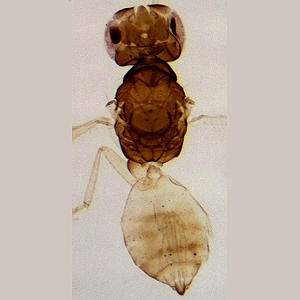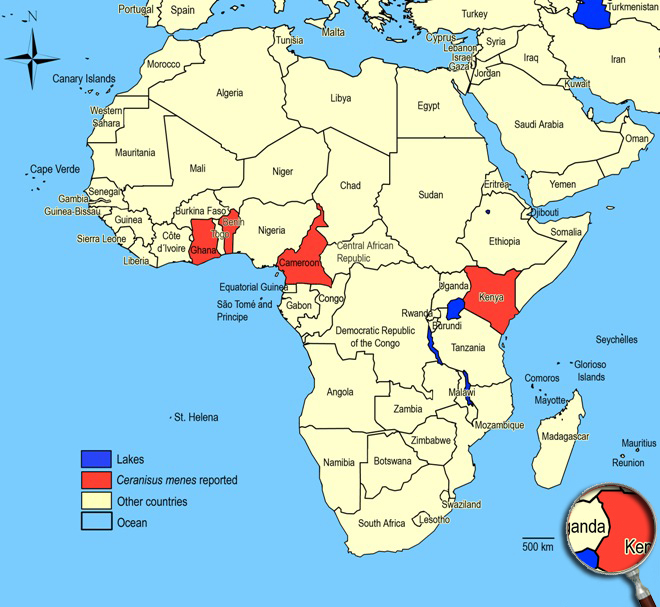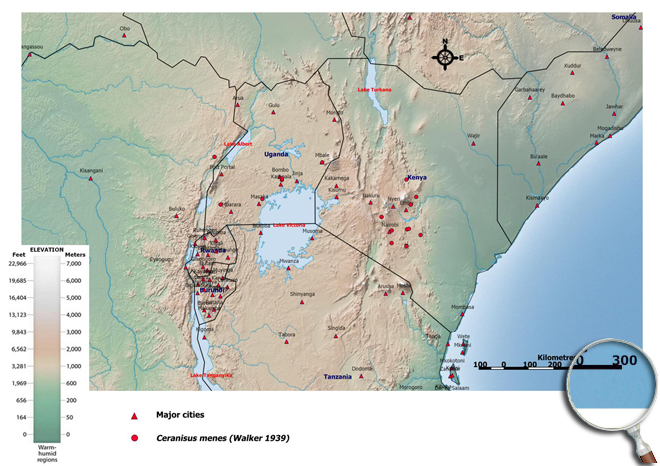Alam MM (1974). Biological control of insect pests of horticultural crops in Barbados, pp. 253-261. In Braithwaite CWD, Phelps RH & Bennett FD [eds.], Crops protection in the Caribbean. Proceedings of a Symposium on the Protection of Horticultural Crops in the Caribbean, Trinidad, April 8-11, 1974
Baltazar CR (1966). A catalogue of Philippine Hymenoptera (with a bibliography, 1758-1963). Pacific Insects Monograph. 8: 1-488
Bazzochi G & Santi F (1994). Comportamento di Ceranisus menes (Walker) (Hymenoptera: Eulophidae) parasitoide di Frankliniella occidentalis (Pergande) (Thysanoptera: Thripidae). Atti XVII Congresso Nazionale Italiano di Entomologia, Udine, 13-18 giugnio, pp. 891-892
Bouček Z (1976). Taxonomic studies on some Eulophidae [Hym.] of economic interest mainly from Africa. Entomophaga. 21(4): 401-414
Bouček Z (1988). Australasian Chalcidoidea (Hymenoptera): a biosystematic revision of genera of fourteen families, with a reclassification of species. CAB International, Wallingford, Oxon, UK, 832 pp
Bühl C (1937). Beiträge zur Kenntnis der Biologie, wirtschaftlichen Bedeutung und Bekämpfung von Kakothrips robustus Uz. Zeitschrift für angewandte Entomologie. 23 (1): 65-113
Carl KP (1971). Report of the work carried out at the European station. Investigation of the natural enemies of thrips for the use as biological control agents against glasshouse thrips in the United Kingdom. CIBC Report, European Station, Delémont, Switzerland, pp. 9-35
Castineiras A, Baranowski RM & Glenn H (1996). Temperature response of the two strains of Ceranisus menes (Hymenoptera: Eulophidae) reared on Thrips palmi (Thysanoptera: Thripidae). The Florida Entomologist. 79 (1): 13-19
Chang NT (1990). Ceranisus menes (Walker) (Eulophidae: Hymenoptera), a new parasite of bean flower thrips, Megalurothrips ustiatus (Bagnall) (Thripidae: Thysanoptera). Plant Protection Bulletin, Taichung. 32 (3): 237-238
Clausen CP (1978). Thysanoptera, pp. 18-21. In Bartlett BR, Clausen CP & de Bach P [eds.], Introduced parasites and predators of arthropod pests and weeds: a world review. USDA, Agriculture Handbook No. 480, Washington, 545 pp
de Santis L (1961). Dos nuevos parásitos de tisanopteros de la República Argentina (Hymenoptera: Entodontidae). Notas del Museo de La Plata, Zoologia. 20 (187): 11-19
de Santis L & Fidalgo P (1994). Catálogo de los Himenópteros Calcidoideos de América al sur de los Estados Unidos. Tercer suplemento (Insecta). Serie de la Academia Nacional de Agronomía y Veterinaria. 13: 1-154
Dessart P & Bournier A (1971). Thrips tabaci Lindman (Thysanoptera), hôte inattendu ďAphanogmus fumipennis (Thomson) (Hym. Ceraphronidae). Bulletin & Annales de la Société Royale ďEntomologie de Belgique.107: 116-118
de Vere Graham MWR (1959). Keys to the British genera and species of Elachertinae, Eulophinae, Entedontinae and Euderinae (Hym., Chalcidoidea). Transactions of the Society for British Entomology. 13 (10): 169-204
de Vere Graham MWR (1963). Additions and corrections to the British list of Eulophidae (Hym., Chalcidoidea), with descriptions of some new species. Transactions of the Society for British Entomology. 15: 167-275
Diop K (2000). The biology of Ceranisus menes (Walker) (Hym., Eulophidae), a parasitoid of the bean flower thrips Megalurothrips sjostedti (Trybom) (Thysanoptera: Thripidae): a comparison between African and Asian populations. PhD thesis, University of Ghana, Legon, Ghana, 165 pp
Doğanlar M, Gumovsky A & Doğanlar O (2009). A new species of the menes species group of the genus Ceranisus (Hymenoptera: Eulophidae) from Turkey. Türkiye Entomoloji Dergisi. 33 (4): 265-278
Doğanlar M & Triapitsyn SV (2007). Review of Ceranisus (Hymenoptera: Eulophidae) of Turkey, with description of a new species. European Journal of Entomology. 104 (1): 105-110
Erdös J (1956). Additamenta ad cognitionem faunae Chalcidoidarum in Hungaria et regionibus finitimis. VI. Eulophidae. Folia Entomologica Hungarica (Series Nova). 9: 1-64
Fourez A (1995). Influence of age of the hosts Frankliniella occidentalis (Thysanoptera: Thripidae) on the parasitism efficiency by Ceranisus menes (Hymenoptera: Eulophidae). Program of the 47th International Symposium on Crop Protection, Gent, p. 14
Fourez A & van Impe G (1995). Influence of larval age of Frankliniella occidentalis (Pergande) (Thysanoptera: Thripidae) on parasitism efficiency by Ceranisus menes (Walker) (Hymenoptera: Eulophidae). Mededelingen Faculteit Landbouwkundige en Toegepaste Biologische Wetenschappen Universiteit Gent. 60 (3 A): 865-868
Franssen CJH & van Heurn WC (1932). Biologie en bestrijding van de sjalottentrips (Thrips tabaci Lindn.). Korte mededeelingen van het Instituut voor Plantenziekten. 18: 1-19
Fullaway DT & Dobroscky ID (1934). A new Thripoctenus parasite from the Philippines. Proceedings of the Fifth Pacific Science Congress (Canada, 1933). 5: 3439-3444
Gahan AB (1932). Miscellaneous descriptions and notes on parasitic Hymenoptera. Annals of the Entomological Society of America. 25 (4): 736-757
Galazzi D & Bazzocchi G (1993). Ceranisus menes. Informatore Fitopatologico. 43 (3): 47-50
Galazzi D, Maini S & Loomans AJM (1992). Ceranisus menes (Walker) (Hymenoptera: Eulophidae): collection and initial rearing on Frankliniella occidentalis (Pergande) (Thysanoptera: Thripidae). Bollettino del ľInstituto di Entomologia "Guido Grandi" della Università degli Studi di Bologna. 46: 123-129
Gibson, G.A.P., Read, J.D. & Fairchild, R. 1998. Chalcid wasps (Chalcidoidea): illustrated glossary of positional and morphological terms
Girault AA (1915). Australian Hymenoptera Chalcidoidea - IV. Supplement. Memoirs of the Queensland Museum. 3: 180-299
Girault AA (1934). New Capsidae and Hymenoptera, with note on an unmentionable. Privately published, Sidney, 4 pp. In Gordh G, Menke AS, Dahms EC & Hall EC (1979). The privately printed papers of A. A. Girault. Memoirs of the American Entomological Institute 28, 400 pp
Goodwin S & Steiner MY (1996). Biological control of thrips, pp. 76-81. In, Proceedings of the 1995 Australian and New Zealand Thrips Workshop: Methods, Biology, Ecology and Management, NSW Agriculture, Gosford, Australia, 25th-27th July, 1995
Greene ID & Parrella MP (1993). An entomophilic nematode, Thripinema nicklewoodii and an endoparasitic wasp, Ceranisus sp. parasitizing Frankliniella occidentalis in California. IOBC/WPRS Bulletin. 16 (2): 47-50
Hirose Y (1989). Exploration for natural enemies of Thrips palmi in Southeast Asia. Institute of Biological Control, Faculty of Agriculture, Kyushu University Fukuoka, 58 pp
Hirose Y (1990). Prospective use of natural enemies to control Thrips palmi (Thysanop., Thripidae), pp. 135-141. In Bay-Petersen J [ed.], The use of natural enemies to control agricultural pests. Proceedings of the International Seminar "The use of parasitoids and predators to control agricultural pests", Tsukuba, Japan, October 2-7, 1989. FFTC book series 40
Hirose Y, Kajita H, Takagi M, Okajima S, Napompeth B & Buranapanichpan S (1993). Natural enemies of Thrips palmi and their effectiveness in the natural habitat, Thailand. Biological Control. 3 (1): 1-5
Hirose Y, Takagi M & Kajita H (1992). Discovery of an indigenous parasitoid of Thrips palmi Karny (Thysanoptera: Thripidae) in Japan: Ceranisus menes (Walker) (Hymenoptera: Eulophidae) on eggplant in home and truck gardens. Applied Entomology and Zoology. 27 (3): 465-467
Ishii T (1933). Notes on two hymenopterous parasites of Thrips in Japan. Japanese Journal of Entomology (Konchū). 7 (1): 13-16
Kurosawa M (1931). A hymenopterous parasite on thrips of onion in Japan. Japanese Journal of Entomology (Konchū). 5: 188
Kutter H (1936). Über einen neuen Endoparasiten (Thripoctenus, Chalcididae) des Erbsenblasenfusses (Kakothrips robustus Uzel), seine Lebensweise und Entwicklung. Mitteilungen der Schweizerischen Entomologischen Gesellschaft. 16 (9): 640-652
Lacasa A, Contreras J, Sánchez JA, Lorca M & García F (1996). Ecology and natural enemies of Frankliniella occidentalis (Pergande, 1895) in south-east Spain. Folia Entomologica Hungarica. 57 (Supplement): 67-74
Lacasa A, Sánchez JA & Lorca M (1996). Aspectos ecológicos de los parásitos de los tisanópteros en España. Boletín de Sanidad Vegetal, Plagas. 22 (2): 339-349
Loomans AJM (1991). Collection and first evaluation of hymenopterous parasites of thrips as biological control agents of Frankliniella occidentalis. IOBC/WPRS Bulletin. 14 (5): 73-82
Loomans AJM (1997). Intraspecific variation in thrips and its relevancy to biocontrol. Proceedings of the Section Experimental and Aplied Entomology of the Netherlands Entomological Society, Amsterdam. 8: 165-170
Loomans AJM (2003). Parasitoids as biological control agents of thrips pests. Thesis, Wageningen University, Netherlands, 200 pp
Loomans AJM (2006). Exploration for hymenopterous parasitoids of thrips. Bulletin of Insectology. 59 (2): 69-83
Loomans AJM & Murai T (1994). Comparison of life-histories of different colour types of Ceranisus menes (Hymenoptera: Eulophidae), parasitoid of Frankliniella occidentalis (Thysanoptera: Thripidae). Proceedings of the Section Experimental and Applied Entomology of the Netherlands Entomological Society, Amsterdam. 5: 35-40
Loomans AJM, Murai T & Green ID (1997). Interactions with hymenopterous parasitoids and parasitic nematodes, pp. 355-397. In Lewis T [ed.], Thrips as crop pests. CAB International, Wallingford, Oxon, UK
Loomans AJM, Murai T, van Heest JPNF & van Lenteren JC (1995). Ceranisus menes (Hymenoptera: Eulophidae), for control of western flower thrips: biology and behaviour, pp. 263-268. In Parker BL, Skinner M & Lewis T [eds.], Thrips biology and management. NATO ASI Series A, Life Sciences, 276. Plenum Publishing Co. Ltd., New York
Loomans AJM & Pákozdi A (1996). Differential acceptance of Ceranisus menes (Walker) and Ceranisus americensis (Girault) attacking thrips hosts, Frankliniella occidentalis (Pergande) and Thrips tabaci (Lind.). Folia Entomologica Hungarica. 57 (Supplement): 83-90
Loomans AJM, Paris A & van Lenteren JC (1993). Influence of size of Frankliniella occidentalis (Thys.: Thripidae) larvae on host acceptance by Ceranisus menes (Hym.: Eulophidae). IOBC/WPRS Bulletin. 16 (2): 101-104
Loomans AJM, Silva I & van Lenteren JC (1992). Ceranisus menes (Hymenoptera: Eulophidae), a potential biological control agent of Frankliniella occidentalis (Thysanoptera: Thripidae)? Proceedings of the Section Experimental and Applied Entomology of the Netherlands Entomological Society, Amsterdam. 3: 40-45
Loomans AJM, Tolsma J, Fransen JJ & van Lenteren JC (2006). Releases of parasitoids (Ceranisus spp.) as biological control agents of western flower thrips (Frankliniella occidentalis) in experimental greenhouses. Bulletin of Insectology. 59 (2): 85-97
Loomans AJM & van Lenteren JC (1990). Hymenopterous parasites as biological control agents of Frankliniella occidentalis (Perg.)? IOBC/WPRS Bulletin. 13 (5): 109-114
Loomans AJM & van Lenteren JC (1994). Evaluation of the effectiveness of parasitic wasp for the biological control of thrips pests in protected crops: state of affairs. IOBC/WPRS Bulletin. 17 (5): 158-164
Loomans AJM & van Lenteren JC (1995). Biological control of thrips pests: a review on thrips parasitoids, pp. 89-201. In Loomans AJM, van Lenteren JC, Tommasini MG, Maini S & Riudavets J [eds.], Biological control of thrips pests. Wageningen Agricultural University Papers, 95-1. Veenman Drukkers, Wageningen, The Netherlands
Mills NJ (1991). Thrips biocontrol: opportunities for use of natural enemies against the pear thrips, pp. 373-391. In Parker BL, Skinner M & Lewis T [eds.], Towards understanding Thysanoptera. Proceedings International Conference on Thrips, Burlington, Vermont, USA, February 21-23, 1989. General Technical Report NE-147. USDA, Forest Service, North Eastern Forest Experiment Station
Mohan Daniel A (1986). Thrips-parasite interactions in some panchaetothripine Thysanoptera (Insecta: Arthropoda). Proceedings of the Indian National Science Academy, Part B, Biological Sciences. 52 (4): 437-444
Mohan Daniel A, Suresh Kumar N & Bakthavatsalam N (1983). Bioecology of Zaniothrips ricini Bhatti (Panchaetothripinae: Terebrantia: Thysanoptera) - A new thrips pest of castor (Ricinus communis: Euphorbiaceae). Proceedings, Indian Academy of Sciences, Section B, Part 1, Animal Scienes. 92 (2): 87-94
Mohan Daniel A, Suresh Kumar N & Bakthavatsalam N (1986). Thrips-crop-weed interactions of Thrips palmi Karny and Toxothrips ricinus Bhatti infesting Sesamum indicum and Ricinus communis. Proceedings of the Indian National Science Academy, Part B, Biological Sciences. 52 (3): 358-363
Murai T (1988a). Studies on the ecology and control of flower thrips, Frankliniella intonsa (Trybom). Bulletin of the Shimane Agricultural Experiment Station. 23: 1-73
Murai T (1988b). Development and reproduction of the parasitoid, Ceranisus brui (Vuillet) (Hymenoptera: Eulophidae), p. 397. Proceedings of the 18th International Congress of Entomology, Vancouver, Canada, July 3-9, 1988
Murai T (1990). Rearing method and biology of thrips parasitoid, Ceranisus menes. IOBC/WPRS Bulletin. 13 (5): 142-146
Murai T, Imai T & Maekawa M (2000). Methyl anthranilate as an attractant for two thrips species and the thrips parasitoid Ceranisus menes. Journal of Chemical Ecology. 26 (11): 2557-2565
Murai T, Kawai S, Chongratanameteekul W & Nakasuji F (2000). Damage to tomato by Ceratothripoides claratris (Shumsher) (Thysanoptera: Thripidae) in central Thailand and a note on its parasitoid, Goetheana shakespearei Girault (Hymenoptera: Eulophidae). Applied Entomology and Zoology. 35 (4): 505-507
Murai T & Loomans AJM (1995). Host-parasite interaction between Frankliniella intonsa, western flower thrips and Ceranisus menes (Hymenoptera: Eulophidae): development and reproduction, pp. 269-275. In Parker BL, Skinner M & Lewis T [eds.], Thrips biology and management. ASI Series A, Life Sciences, 276. Plenum Publishing Co. Ltd., New York
Murai T & Loomans AJM (2001). Evaluation of an improved method for mass-rearing of thrips and a thrips parasitoid. Entomologia Experimentalis et Applicata. 101 (3): 281-289
Napompeth B (1990). Use of natural enemies to control agricultural pests in Thailand, 8-29. In Bay-Petersen J [ed.], The use of natural enemies to control agricultural pests. Proceedings of the International Seminar "The use of parasitoids and predators to control agricultural pests", Tsukuba, Japan, 2-7 October 1989. FFTC Book series 40
Narayanan E (1971). Report of the work carried out at the Indian station. Investigation of the natural enemies of thrips for the use as biological control agents against glasshouse thrips in the United Kingdom. CIBC Report, European Station, Delémont, Switzerland, pp. 3-5
Rubin A & Kuslitzky W (1992). First record of Ceranisus menes (Hymenoptera: Eulophidae) in Israel. Phytoparasitica. 20 (2): 123-124
Sakimura K (1937a). On the bionomics of Thripoctenus brui Vuillet, a parasite of Thrips tabaci Lind., in Japan, I. Japanese Journal of Entomology (Konchū). 11 (5): 370-390
Sakimura K (1937b). On the bionomics of Thripoctenus brui Vuillet, a parasite of Thrips tabaci Lind., in Japan, II. Japanese Journal of Entomology (Konchū). 11 (6): 410-424
Sakimura K (1937c). Introduction of Thripoctenus brui Vuillet, parasite of Thrips tabaci Lind., from Japan to Hawaii. Journal of Economic Entomology. 30 (5): 799-802
Saxena RC (1971). Some observations on Ceranisus sp. (Hymenoptera, Eulophidae) parasitizing Thrips tabaci Lind. (Thysanoptera: Thripidae). Indian Journal of Entomology. 33 (1): 91-92
Saxena RC (1981). Observations on some predators and parasites of Thrips tabaci Lind. Bulletin of Entomology. 22: 97-100
Schauff M (1991). The Holarctic genera of Entedoninae (Hymenoptera: Eulophidae). Contributions of the American Entomological Institute. 26 (4): 1-109
Shimada T (1998). Seasonal prevalence of two species of hymenopterous parasitoids of thrips. Proceedings of the Kanto-Tosan Plant Protection Society. 45: 225-226
Steiner MY & Goodwin S (1998). Methods for collecting and rearing thrips (Thysanoptera) and their natural enemies. Australian Journal of Entomology. 37(2): 101-106
Swezey OH (1937). Thripoctenus brui Vuillet. Proceedings of the Hawaiian Entomological Society. 10 (1): 23-24
Swezey OH (1950). Thripoctenus brui Vuillet. Proceedings of the Hawaiian Entomological Society. 14 (1): 10
Swezey OH, Fullaway DT & Sakimura K (1939). Recent records of the introduction of beneficial insects into the Hawaiian Islands. Proceedings of the Hawaiian Entomological Society. 10 (2): 349-352
Swezey OH (1937). Thripoctenus brui Vuillet. Proceedings of the Hawaiian Entomological Society. 10 (1): 23-24
Swezey OH (1950). Thripoctenus brui Vuillet. Proceedings of the Hawaiian Entomological Society. 14 (1): 10
Swezey OH, Fullaway DT & Sakimura K (1939). Recent records of the introduction of beneficial insects into the Hawaiian Islands. Proceedings of the Hawaiian Entomological Society. 10 (2): 349-352
Tachikawa T (1986). A note on Ceranisus brui (Vuillet) in Japan (Hymenoptera, Chalcidoidea, Eulophidae). Transactions of the Shikoku Entomological Society. 17 (4): 267-269
Tagashira E & Hirose Y (2001). Development and reproduction of Ceranisus menes (Hymenoptera: Eulophidae), a larval parasitoid of thrips: effects of two host species, Frankliniella intonsa and Thrips palmi (Thysanoptera: Thripidae). Applied Entomology and Zoology. 36 (2): 237-241
Tamò M, Arodokoun DY, Zenz N, Tindo M, Agboton C & Adeoti R (2002). The importance of alternative host plants for the biological control of two key cowpea insect pests, the pod borer Maruca vitrata (Fabricius) and the flower thrips Megalurothrips sjostedti (Trybom), pp. 81-93. In Fatokun CA, Tarawali SA, Singh BB, Kormawa PM, & Tamò M [eds.], Challenges and opportunities for enhancing sustainable cowpea production. Proceedings of the World Cowpea Conference III held at the International Institute of Tropical Agriculture (IITA), Ibadan, Nigeria, 4-8 September 2000. IITA, Ibadan, Nigeria
Tamò M, Baumgärtner J, Delucchi V & Herren HR (1993). Assessment of key factors responsible for the pest status of the bean flower thrips Megalurothrips sjostedti (Trybom) (Thysanoptera, Thripidae). Bulletin of Entomological Research. 83: 251-258
Tamò M, Bottenberg H, Arodokoun D & Adeoti R (1997). The feasibility of classical biological control of two major cowpea insect pests, pp. 259-270. In Singh BB, Mohan Raj DR, Dashiell KE & Jackai LEN [eds.], Advances in cowpea research. Copublication of International Institute of Agriculture (IITA) and Japan International Center for Agricultural Sciences (JIRCAS). IITA, Ibadan, Nigeria
Tamò M, Ekesi S, Maniania NK & Cherry A (2003). Biological control, a non obvious component of Integrated Pest Management for Cowpea. In: Neuenschwander, C., Borgemeister, C., Langewald, J. (eds.). Biological Control in Integrated Pest Management Systems in Africa. CAB International, Wallingford, pp. 295-309
Teulon DAJ, Cameron EA & Loomans AJM (1996). In search of the univoltine Thysanopteran parasitoids, Ceranisus menes Walker and C. pacuvius Walker (Hym., Eulophidae). Entomologisťs Monthly Magazine. 132: 177-182
Triapitsyn SV (2005). Revision of Ceranisus and the related thrips-attacking entedonine genera (Hymenoptera: Eulophidae) of the world. African Invertebrates. 46: 261-315
Triapitsyn SV & Headrick DH (1995). A review of the Nearctic species of the thrips-attacking genus Ceranisus Walker (Hymenoptera: Eulophidae). Transactions of the American Entomological Society. 121 (4): 227-248
Triapitsyn SV & Morse JG (1999). Survey of parasitoids of citrus thrips, Scirtothrips citri (Moulton, 1909) in southern California. Russian Entomological Journal. 8 (1): 47-50
Triapitsyn SV & Morse JG (2005). A review of the species of Ceranisus Walker (Hymenoptera: Eulophidae) in the New World. Transactions of the American Entomological Society. 131 (1+2): 69-86
Valentine EW (1967). A list of the hosts of entomophagous insects of New Zealand. New Zealand Journal of Science. 10 (4): 1100-1209
van Heurn WC (1923). Over een waarschijnlijke parasiet (Thripoctenus brui Vuillet) en een vermoedelijke hyperparasiet (Genus? species?) van Thrips tabaci Lind. Tijdschrift voor Entomologie. 66: 119-128
Vuillet A (1914). Notes sur un Chalcidien parasite de thrips des pois. Comptes Rendus des Séances de la Société de Biologie et de ses Filiales. 75: 552-554
Walker F (1839). Monographia Chalciditum. Vol. 1. Bailliŕe, London, 333 pp
Yoshimoto CM (1965). Synopsis of Hawaiian Eulophidae including Aphelininae (Hym.: Chalcidoidea). Pacific Insects. 7 (4): 665-699
Zenz N (1999). Effect of mulch application in combination with NPK fertilizer in cowpea (Vigna unguiculata [L.] Walp.; Leguminosae) on two key pests, Maruca vitrata F. (Lepidoptera: Pyralidae) and Megalurothrips sjostedti Trybom (Thysanoptera: Thripidae), and their respective parasitoids. PhD thesis, University of Hohenheim, Germany, 379 pp












